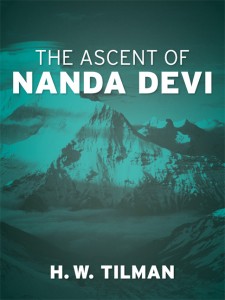
The Ascent of Nanda Devi, Tilman
Nanda Devi, once believed to be the highest mountain in India, has been climbed only thirteen times so far. The first attempt on the mountain was made in 1934 by two mountaineering legends, Shipton and Tilman. However, they didn’t succeed and that made Tilman come back again in 1936. The Ascent Of Nanda Devi is a gripping account of their three month long journey to the top of the 7816 m high mountain.
And it remained the highest mountain climbed until the 1950 ascent of Annapurna (8091 m).
The Mother Goddess – Nanda Devi is a fickle mistress, beautiful yet authoritative. In 1930, Hugh Ruttledge tried his luck thrice with the mountain and every time he was lost in the vast sanctuary that serves as the gateway to the great mountain. The labyrinthine corridors of the sanctuary exhausted him both mentally as well as physically. Thrice he tried and every time he failed. Shipton and Tilman succeeded in solving the ‘sanctuary maze’ in 1934 but that was it. It was not until 1936 that the summit was made.
The summit was still two years ahead.
Ruttledge concluded, “Nanda Devi imposes on her votaries an admission test as yet beyond their skill and endurance’, adding that gaining entry to the Nanda Devi Sanctuary alone was more difficult than reaching the North Pole.”
The 1936 expedition aimed at summiting the Kangchenjunga but the then GOI decided against it and the expedition turned towards Gharwal and all eyes were now fixed at Nanda Devi. The expedition involved four Undergrad students from Harvard Mountaineering Club teaming up with Tilman and three other experienced mountaineers. In a way, the expedition itself came together by chance.
Tilman and team explored the area around Joshimath and Ranikhet, gathered all the possible help they could, in terms of porters, food, and local inputs. Porters were invited from as fas as Mana Village. The party left Ranikhet on 29 May and exactly after three months, on 29 August the summit was made by Tilman and Odell.
The party included 8 climbers and over 100 odd porters from different parts of Garhwal, Mana, and Kumaun. The party initially followed the route established by Shipton and Tilman in 1934. By the time they reached the base of the mountain, most of the porters had left them.
They established four camps to the summit and by the time they arrived at the last camp, only Odell and Tilman were physically fit to take the final call to the top.
Tilman’s summit opened the valley for subsequent explorations and the mountain was climbed 12 times, out of which 6 times Indian teams reached the summit.
“I believe we so far forgot ourselves as to shake hands on it”, said Tilman to Odell upon reaching the top of Nanda Devi. One of the finest travel expeditions you’ll ever read.
An ebook is available on both Amazon and Flipkart. Even a hard copy is available at Flipkart. If you can afford it, unlike me, you must buy it. An ebook can never beat the feel of a real book.
Suggested Reading: Nanda Devi Climbing History | CIA Secret Mission to Nanda Devi | Nanda Devi Unsoeld’s Story

The Mother Goddess – Nanda Devi
The Roskelley Collection: Stories Off the Wall, Nanda Devi, and Last Days is a nice follow up to this book. Its available in electronic format on Google Play books.
Nanda devi comes with its own set of anecdotes.
In 1965, Schaller was part of an American spy team that tried to place a nuclear-powered surveillance device on top of Nanda Devi, one of the highest mountains in the world.
An excellent article covering Schaller can be found on – http://www.seattlepi.com/local/article/Spy-Robert-Schaller-s-life-of-secrecy-betrayal-1232285.php?source=mypi